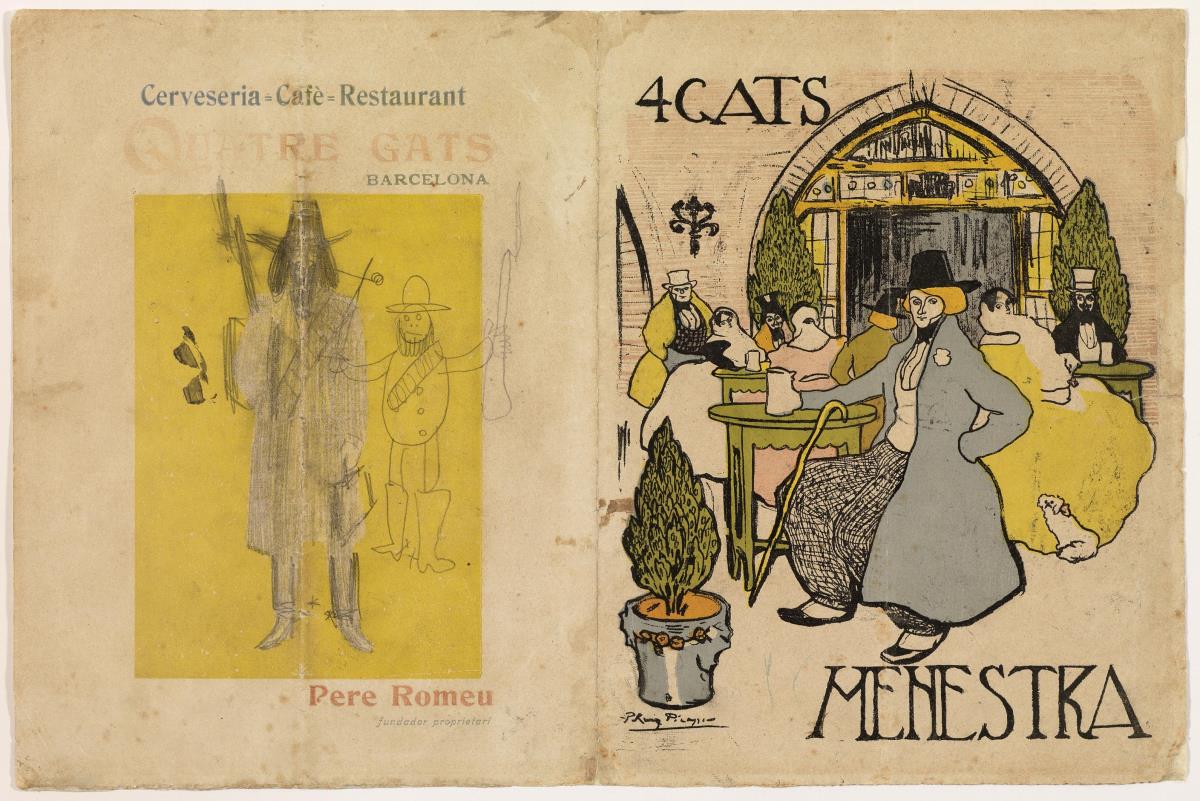The alehouse-tavern-hostel called the Quatre Gats opened its doors in 1897, during a period of full artistic effervescence. Barcelona was living a "golden age" of lights and shade with the demographic growth caused by the rural migration to the urban areas, industrial development and the tensions between the social classes.
 Pablo Picasso. Pere Romeu caricaturitzat de bòer, i altres croquis (menú de Quatre Gats). Barcelona, 1899-1900. Llapis grafit sobre paper imprès. Donació Picasso, Pablo, 1970. Museu Picasso, Barcelona. MPB 110.813
Pablo Picasso. Pere Romeu caricaturitzat de bòer, i altres croquis (menú de Quatre Gats). Barcelona, 1899-1900. Llapis grafit sobre paper imprès. Donació Picasso, Pablo, 1970. Museu Picasso, Barcelona. MPB 110.813
Right in the middle of these airs of change, the Bohemian currents entered in force in the tavern of Els Quatre Gats that, after a period of certain lethargy, raised its head thanks to the boosting of Renaissance. Various artists and local businessmen, lovers of culture, proposed opening a venue in Barcelona that would be the meeting point and place of debate of these trends. The people who inspired this project were: Miquel Utrillo, Santiago Rusiñol, Ramon Casas and Pere Romeu, all of the influenced by another emblematic restaurant, “Le Chat Noir”, founded by Rodolphe Salis in Paris in 1881 and closed in 1897.
Els Quatre Gats would quickly become a neuralgic point in which restless artists and writers came to keep up-to-date with the latest news from the city of lights. Among the youngest, was notably a young Picasso of 17 years old, but also Casagemas, the brothers Mateu and Àngel Fernández de Soto, the Raventós brothers, Sabartés, etc.
Pablo Picasso. Cafè concert, nan i bust de dona. Barcelona, c. 1899. Llapis Conté i sanguina sobre paper verjurat amb filigrana. 31,1 x 48,1 cm (irregular). Museu Picasso, Barcelona. Donació Pablo Picasso, 1970. MPB 110.573
In this period modern cooking was hatched, so to speak, which led to modernist cuisine, marked by the internationalization of the products made in Catalonia thanks to the Universal Exposition of 1888. A new way of understanding cooking emerged, with the appearance of prepared foods and new techniques such as industrial preserves. The shops dedicated exclusively to food emerged, like the "colmados" (the grocery stores), the pastry shops or the bacalleria (the cod shops) that sold fish already salty and soaked.
With these new ingredients, many thought of adapting to the new rhythm of working women, they changed their shopping behaviour, which transformed society into a consumer society. Businesses such as the Quatre Gats saw how important the claim of advertising was, and posters appeared strongly, always with the dual purpose of the artistic object and advertising.
Pere Romeu, the person in charge of Els Quatre Gats, quickly noticed Picasso, a young promise with a lot of potential. He commissioned Picasso to do various graphic works, a responsibility almost exclusive of Casas, but he trusted in him and commissioned an advertising poster of one of the most emblematic activities organised in the establishment: the puppet show.
Pablo Picasso. Croquis del menú de Quatre Gats. Carbonet sobre paper verjurat. 42,9 x 31 cm (irregular). Museu Picasso, Barcelona. Donació Pablo Picasso, 1970. MPB 110.804
Later on, in the spring of 1900, Picasso was commissioned to produce the menu, an important element that reflects the trust in the young artist. Based on many sketches, Picasso situated the scene within the premises, surrounded by a table with a pointed arch in the background, an identifying feature of the tavern. Two definitive versions were done, and in one of them there appears a central character, “a perfect modernist man”: wide-brimmed soft hat, long hair and velvet clothing, etc.
That same year, Picasso painted Interior of Els Quatre Gats with the poet Rafael Nogueras Oller seated with a woman at a table inside the restaurant.
Another important element was the design, alone without the collaboration of Ramon Casas, of the poster to announce the Dish of the Day. Only the preparatory drawing is known, as no published copy has been found.
Pablo Picasso. Menú dels Quatre Gats, "Plat del dia". Menú de Els Quatre Gats, Plat del dia , c. 1900. Ceta i tinta sobre paper. Courtesy of the Hunt Museum. MG 145
If you visit the temporary exhibition “Picasso's kitchen”, in Room 01 you will be able to find some of these works from the period in which he frequented the Quatre Gats along with the masterpiece that accompanies them, Ramon Casas and Pere Romeu on a tandem painted by Casas. An emblematic painting of Catalan Modernism which decorates the alehouse and tavern. The aim of the work with a clear humoristic touch, is to show the technique of poster art, a genre that Ramon Casas had obtained major prestige.
Written by the Museum





